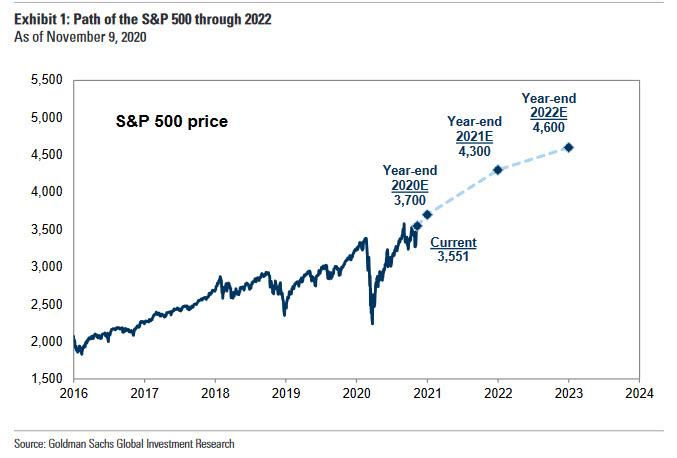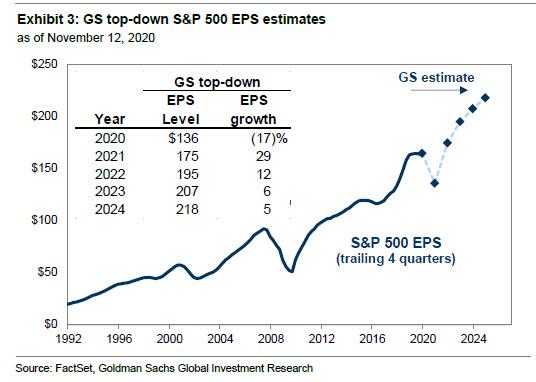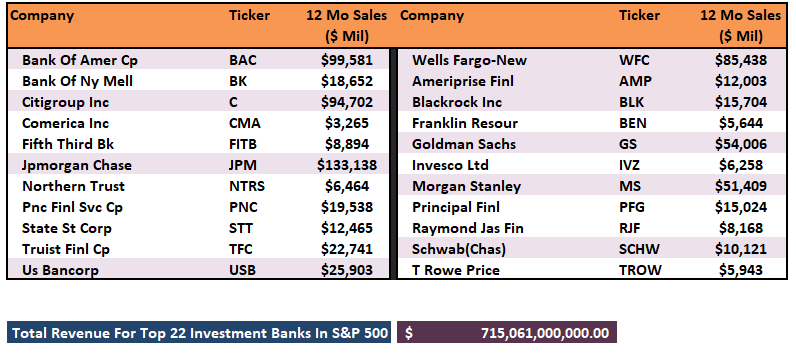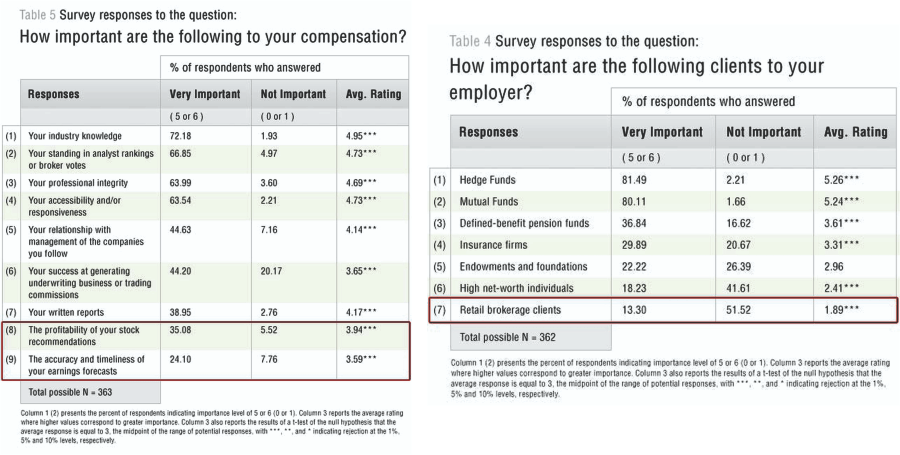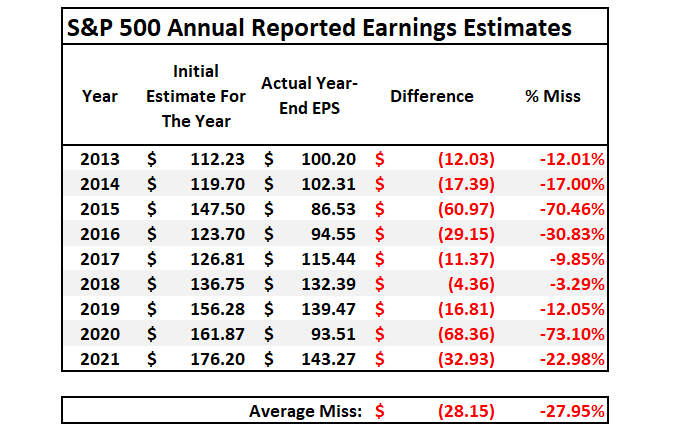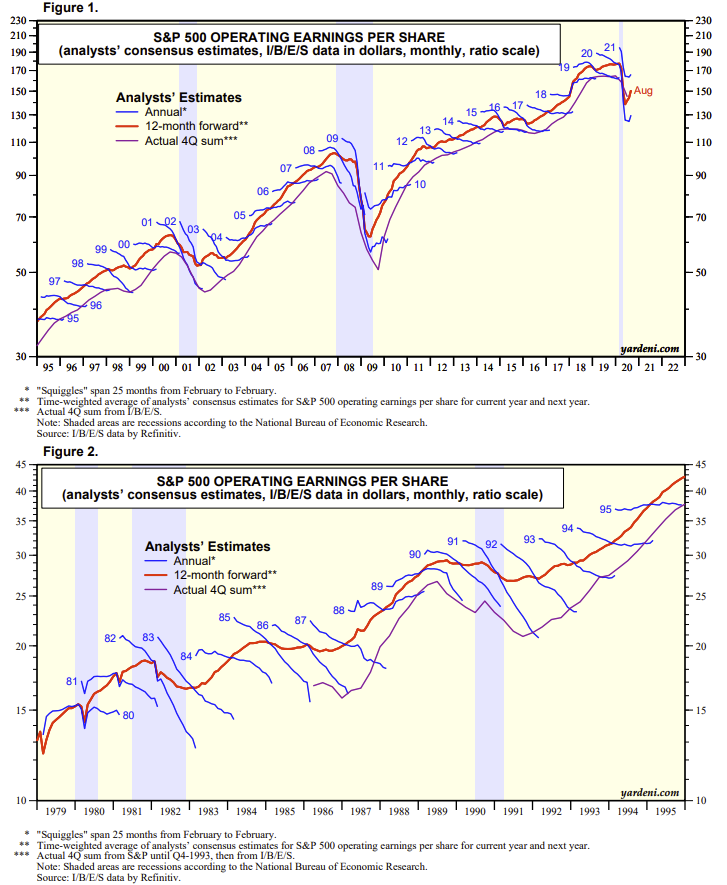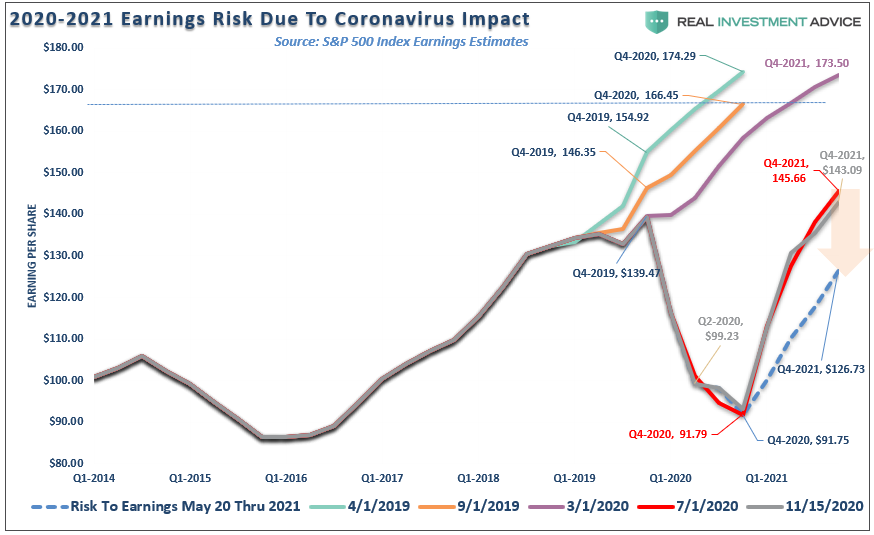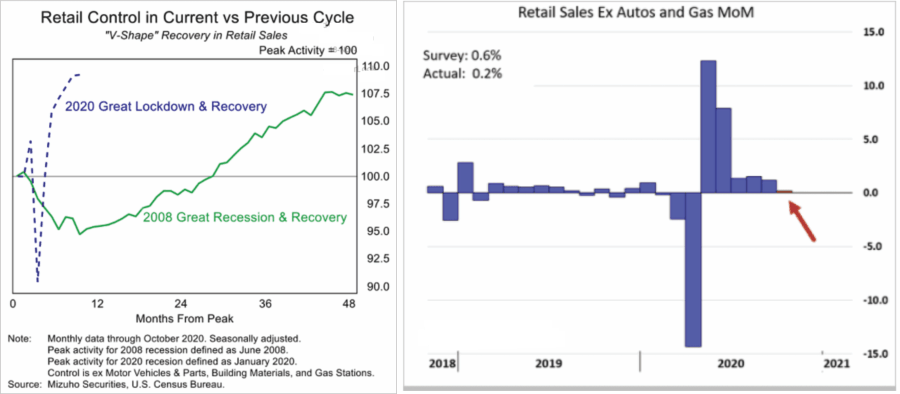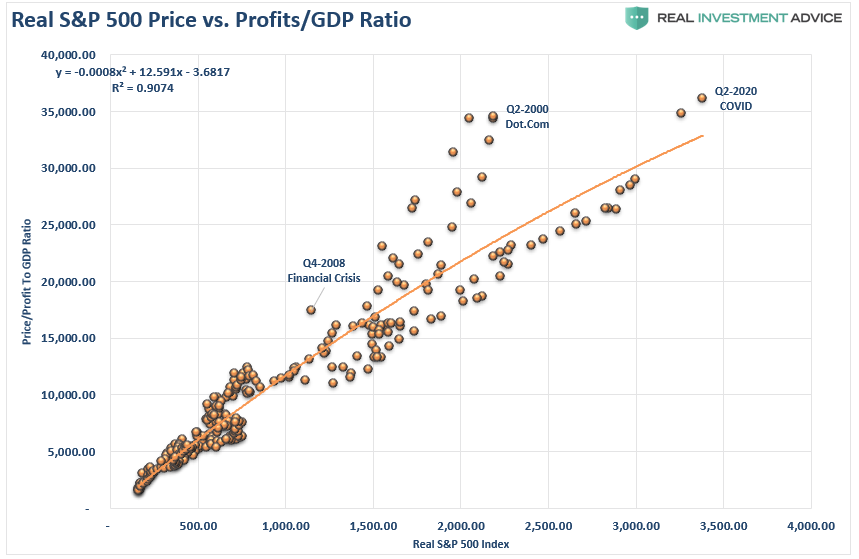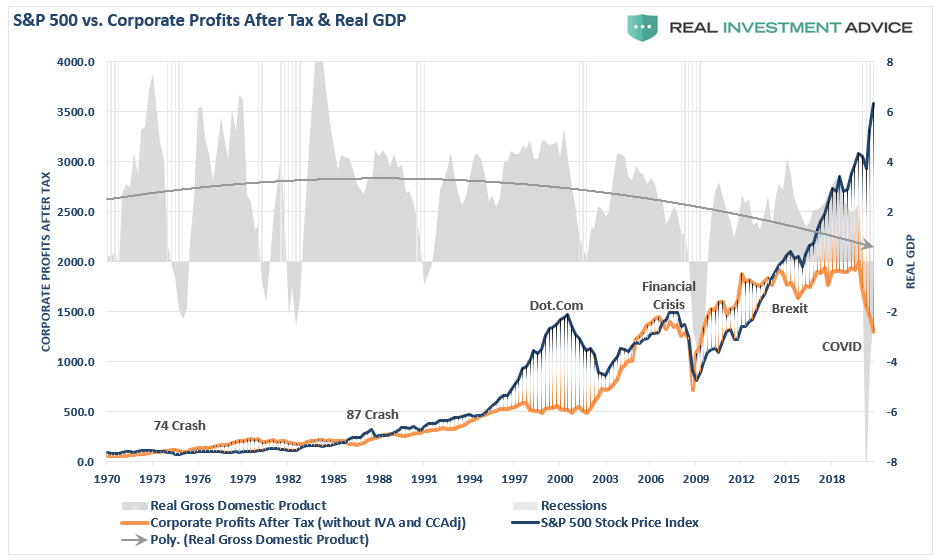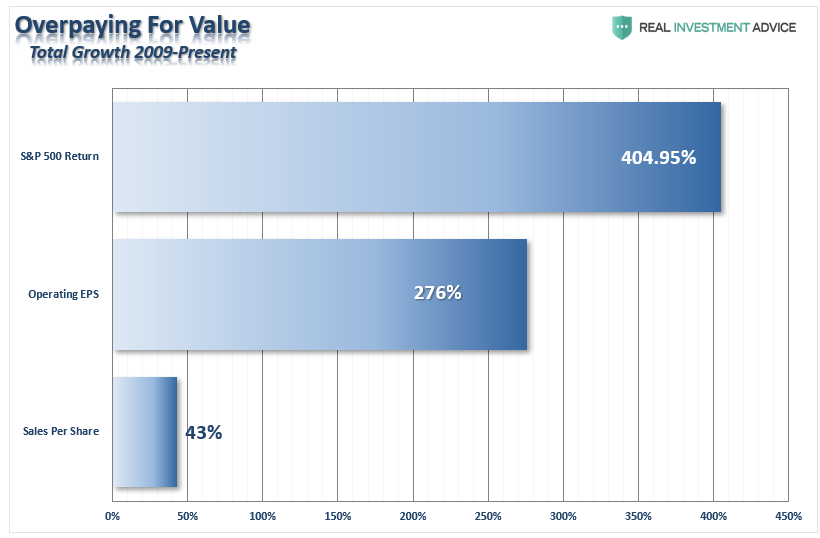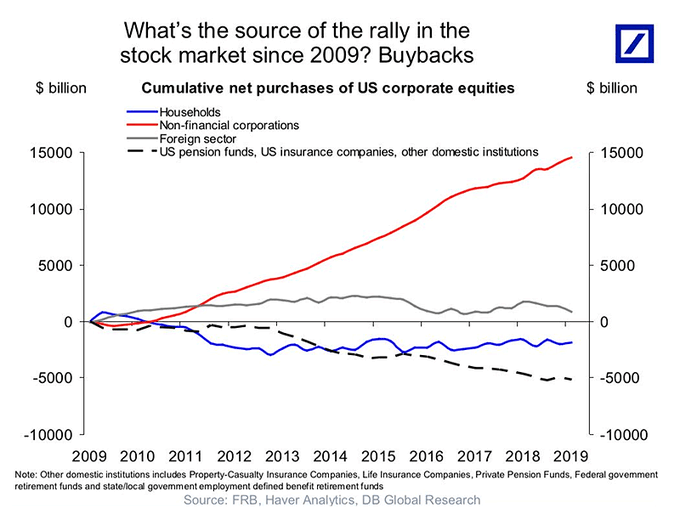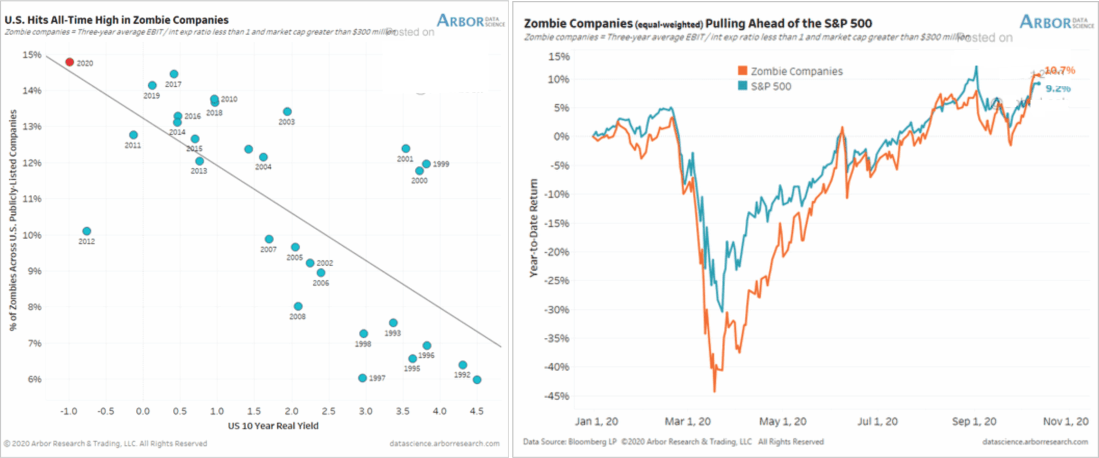It’s that time of year when Wall Street analysts started trotting out the predictions for earnings growth and stock market targets for the coming year. Unfortunately, each year these overly optimistic estimates are ground down as the year progresses. Next year will be no different as earnings growth will disappoint in 2021.
Setting The Bar High
Goldman Sachs hit the ground running this year by putting a 2021 price target on the S&P 500 of 4300 and 4600 by the end of 2022. If we use their “current level” of 3551, such would be a gain of 21.1% for 2021 and roughly 7% for 2022.
To support that growth in stock prices, you need strong earnings growth to keep expensive valuations at some “less crazy” level. To accomplish this feat, Goldman stretched reality to $175 in EPS for 2021 and $195 in 2022. (Note that Goldman used $136 in Operating (Earnings Before Reality) for 2020, which is currently $16 per share higher than S&P is presently reporting.)
Assuming that Goldman Sachs is correct, such would put valuations on the S&P 500 of 24.57x operating earnings in 2021 and 23.59x in 2022. Such levels remain extremely expensive by any historical measure.
The Problem With Estimates
For many years, I have counseled individuals to disregard mainstream analysts, Wall Street recommendations, and even MorningStar ratings due to the inherent conflict of interest between the firms and their particular clientèle. Here is the point:
- YOU are NOT Wall Street’s client.
- YOU are the CONSUMER of the products sold FOR Wall Street’s clients.
Wall Street is a “big” business. I mean a massive industry of $715 Billion a year in revenue. The table below shows the annual sales of 22 of the largest financial firms in the S&P 500.
Like all businesses, these companies are driven by increasing corporate profitability annually, regardless of market conditions. In a previous study by Lawrence Brown, Andrew Call, Michael Clement, and Nathan Sharp, you are not a Wall Street analyst’s priority.
“Countless studies have shown that the forecasts and stock recommendations of sell-side analysts are of questionable value to investors. As it turns out, Wall Street sell-side analysts aren’t primarily interested in making accurate stock picks and earnings forecasts. Despite the attention lavished on their forecasts and recommendations, predictive accuracy just isn’t their main job.”
Where are you in order of importance, at the bottom of the list. Such is because accuracy isn’t essential – it’s only “broker votes” that matter.
“A ‘broker vote’ is an internal process whereby clients of the sell-side analysts’ firms assess the value of their research and decide which firms’ services they wish to buy. This process is crucial to analysts because good broker votes result in revenue for their firm. One analyst noted that broker votes ‘directly impact my compensation and directly impact the compensation of my firm.’”
No Accountability
The problem is that no one in the financial media, Wall Street, or anywhere else holds analysts accountable for their calls. Take a look at the table below using data from S&P Global:
I have stated previously that analysts consistently overestimate earnings by as much as 30%. However, this isn’t just a recent event, as the two charts from Yardeni Research show below.
Of course, the problem is that investors take these estimates from analysts at “face value” and “pay up” for earnings that fail to materialize in the future. Such works out great for Wall Street who makes their investment banking clients happy. However, not so much for their retail clients to whom they are offloading overpriced shares. (IPO’s, secondary offerings, etc.)
2021 Likely To Be Disappointing Once Again
While analysts are rushing to set the highest target price possible and overestimating earnings to “justify” them, the next 12-months will see those targets sharply reduced. Such was a point we made in April of this year as the pandemic’s reality set in. To wit:
“This analysis is based on the presumption, that despite the fact the major buyer of stocks, namely corporate share repurchases, will be missing that earnings will recover sharply once the ‘economy opens back up for business.’
To analyze the reality of these expectations, we need to review the history of the estimates for the S&P 500 from when 2021 estimates were first published by Standard & Poors in April 2019. The chart shows the progression in estimates April to September 2019, and March, July and November of 2020. (The dotted blue line is my original, unrevised estimate of the impact to earnings in May of this year.)”
Currently, estimates for 2021 sit at $143.09. Importantly, with markets presently sitting near all-time highs, 2021 estimates are $30.41/share lower than was initially estimated.
Economic Recovery Won’t Make Up The Difference.
Over the last couple of weeks, we have touched on the various problems with the expected “recovery” even if we get a vaccine in place.
Foremost, the hope that consumers will rush out to spend money due to “pent-up demand” is likely not the case. Had the Government not acted to send money directly to households that exceeded their previous income streams, I would agree with the argument.
However, the flood of stimulus money from direct checks to households and expanded unemployment benefits “pulled forward” future consumption. The comparison between current retail sales and 2008, where the stimulus was not present, is evident.
Secondly, the divergence between the stock market and the economy is unsustainable longer-term. As we discussed in the “Importance Of Market Cap To GDP:”
“Since 1947, earnings per share have grown at 6.21% annually, while the economy expanded by 6.47% annually. That close relationship in growth rates should be logical. Such is particularly the case given the significant role spending has in the GDP equation.”
The correlation is more evident when looking at the market versus the ratio of corporate profits to GDP. With a 90% correlation, investors should not dismiss these deviations.
Slower Growth Ahead
Most importantly, economic growth will not recover back to pre-pandemic growth trends, as noted by Michael Lebowitz recently:
“The new paradigm of weak recoveries is due to the Fed’s policy prescription for recessions; debt-fueled consumption. Through lower interest rates they incentivize people, corporations, and the government to borrow. The benefits are here and now as economic recovery ensues. The cost is paid tomorrow.”
In simpler terms, we pull consumption forward from the future during each recession and accumulate debt in its place. Accordingly, future economic growth is weaker than in the past as debt diverts income from productive investment into debt service.
The changes to the economy over the last 40-years has continued to erode economic growth. Had we grown our economy at the rate of the 1980s, GDP would be over 50% higher than it is currently.
There is no doubt that massive amounts of new federal, municipal, and corporate debt used to weather the COVID storm will have the same economic dampening effect as it has had. Based solely on the strong relationship between government debt ratio to GDP, we estimate that the coming expansion’s real growth rate could be as low as 1.07%.
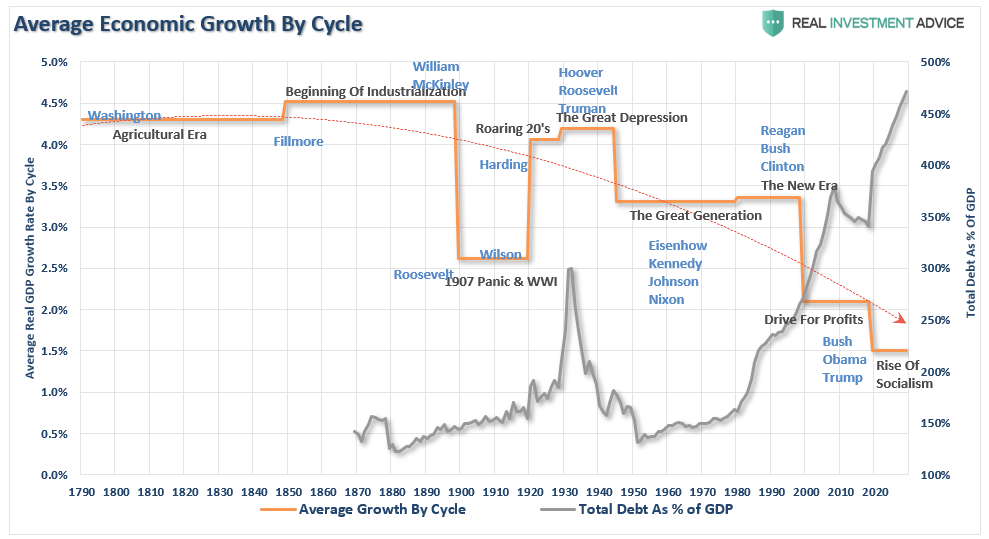
Without economic growth, corporate profits will remain elusive.
While The Fed will continue to supply liquidity, their programs’ efficacy has become less with each iteration. While monetary interventions allow market participants to ignore the reality of the economic ties to the market, as we saw in March, such does not preclude hair-raising volatility and large declines.
In 2021, earnings are likely to come in once again substantially lower than Goldman’s high estimates. But such shouldn’t be a surprise since they are never accurate historically. More importantly, if the Fed backs off, whether by its design or due to inflation, slower economic growth, or massive debt overhead, rich valuations will matter.
The risk of disappointment is high. And so are the costs of being “wilfully blind” to the risks.
Lance Roberts is a Chief Portfolio Strategist/Economist for RIA Advisors. He is also the host of “The Lance Roberts Podcast” and Chief Editor of the “Real Investment Advice” website and author of “Real Investment Daily” blog and “Real Investment Report“. Follow Lance on Facebook, Twitter, Linked-In and YouTube
Customer Relationship Summary (Form CRS)
Also Read








